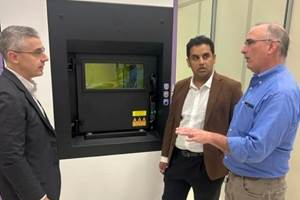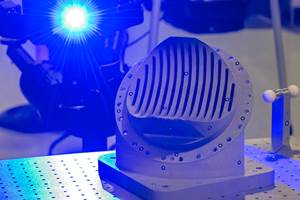An Aerospace Perspective on Additive Manufacturing
A forum recently hosted by the Ohio Aerospace Institute featured compelling reasons for implementing additive manufacturing in the industry. The challenge? Education.
Share
While some lofty goals emerged at a recent additive manufacturing forum hosted by the Ohio Aerospace Institute (OAI) near Cleveland, Ohio, it was the real-time challenges facing additive manufacturers in the aerospace sector that kept attendees’ feet planted firmly on terra firma. The forum served to share existing hurdles to and compelling reasons for implementing additive manufacturing in the aerospace industry—two goals that the forum achieved, though not with absolute parity. Indeed, while success stories had their place at the forum, what became clear was that the hurdles—as well as the opportunities—for AM-produced parts in aerospace are high and numerous.
A Faster Path to Certification
The aerospace sector—which boasts more than $144 billion in export sales alone—is often cited as the most successful in the U.S. economy. Given the fact that implementing AM processes within the sector is relatively new, it should not be unexpected that hurdles exist for creating certifiable parts. The average commercial jet is a $70 million asset responsible for safely transporting untold numbers of human beings, after all. Between the Federal Aviation Administration and the Department of Defense, you have two massive agencies providing oversight and approval of parts that, until recently, have been produced through traditional manufacturing methods for decades.
In fact, additive manufacturing in the aerospace sector, at least for metal parts, is so new that quality control standards and industry certification specs are just now being written and revised—a massive undertaking being headed by a technical committee within SAE’s Aerospace Materials Systems (AMS) Group. (SAE International, originally known as the Society of Automotive Engineers, is a global organization responsible for establishing standards across multiple fields of engineering, but primarily transportation.) During one of his two presentations at the forum, David Abbott, principal engineer with GE Additive and chair of the SAE committee—called the AMS-AM Additive Manufacturing Committee—gave an overview of the group’s work to “develop and maintain aerospace material and process specifications…for additive manufacturing, including precursor material, additive processes, system requirements and post-build materials, pre-processing and postprocessing, nondestructive testing and quality assurance.” No small feat to be sure.
Rich Lonardo, a consultant for the Youngstown Business Incubator, pinpointed AM’s capability to address long lead times for parts as a primary motivation for quickly establishing certification guidelines. Castings made for the Air Force and Navy can take up to 700 days, he said. “We have solutions for that. Within our region, we have a solution for the DoD to smash long lead time problems right now.” What’s missing, he said—and what Dave Abbott and the SAE committee are actively working on—is a certification process that allows AM to reach its potential in delivering parts faster.
“For small solution providers and early adopters, the process is an impediment,” Lonardo said. “It’s not the state or capability of a company’s tech, it is the speed of acquisition and the acquisition process. For the young people out there now who are used to buying things on the internet, they are not going to be satisfied being told it will be 700 days to get a part. They will say go pound sand. They’re going to have a whole different set of requirements for obtaining parts.”
But it also became clear by the end of the forum that while the aerospace industry faces its own specific hurdles, the broader challenges of AM education and awareness must simultaneously be overcome.
Bridging the Gap
A common thread that ran through the sessions involved gaps of understanding within the aerospace sector when it comes to industrial AM. “Design for additive is one of those things that nobody knows,” said Dr. Kirk Rogers, technology leader at GE’s Center for Additive Technology Advancement. “Not a lot is written in books you can go buy on Amazon.” As a means of providing a broad-based primer on additive manufacturing, Rogers addressed various AM-related topics by their levels of complexity, starting with additively-produced jigs and fixtures (Level 0), through L4 complexities that tackle multifunctional requirements and advanced functions, including self-assembling technologies such as those being pioneered by MIT’s Self-Assembly Lab.
Rogers concluded by providing his take on GE chairman and CEO Jeffrey Immelt’s prediction that 25 percent of GE products will be impacted by AM by 2020. “That’s probably already true,” Rogers said.
During a panel discussion about the opportunities for AM in aerospace, Mike Peretti, director of Materials & Manufacturing Advanced Programs at GE Aviation, said that overcoming misconceptions about additive manufacturing—especially in the defense industry—was key. “One of the barriers early on was that when we talked to generals and admirals, (they) thought that AM was going to be like Star Trek replicators. But they’ve really started to understand what AM can do for the DoD.”
Of course, the sense of urgency to implement AM technology in aerospace is being driven not only by AM’s potential within the sector, but also by its established successes. Brian Rice, distinguished research engineer at the University of Dayton Research Institute, pointed to ongoing costs to maintain legacy hardware within the Air Force fleet. He said that its aircraft, some of which are 50 years old, represent a major opportunity to address repair needs through additive manufacturing. As for new AM-produced aerospace technologies, Dave Abbott said that 40 percent of the new GE93 advanced turboprop engine, which has been selected to power the new Cessna Denali, is being manufactured additively with no structural castings. “We started from scratch,” he said, adding that 3D printing allowed more than 850 components to be replaced by 12. “We took a new center line design and applied AM to that design from the start. It shows what can be done from a design perspective with AM.”
Additive Education
“Pushing tech.” This phrase—used to represent existing efforts to educate key stakeholders about AM’s capabilities and challenges within the aerospace sector—emerged more than a few times during the forum. Mike Garvey, president of M-7 Technologies in Youngstown, Ohio, said that the development of AM technologies is outpacing the industry’s ability to educate end users. The AM industry, he said, has done a poor job of pushing the technology effectively—of “telling generals that additive manufacturing is not like a Star Trek replicator.”
Explaining the value proposition is a parallel challenge, according to Garvey. AM is a demand issue driven by an awareness issue, and going into a foundry to push the technology isn’t going to work. “But when GE goes in and creates a demand pool, people start listening,” he said.
Dave Abbott also discussed existing efforts to educate industrial leaders about AM. “The push approach isn’t working,” he said. “We need engineering services. We need to teach the industry how to design for additive.” Dave Pierson, senior product development engineer for Magnet (the Manufacturing Advocacy and Growth Network) in Cleveland, pointed to ongoing misperceptions that manufacturers still have when they first begin exploring additive manufacturing. “A lot of people when they first start out in the AM space, they get a little sticker shock when they learn what a machine costs,” he said. “But I show them what a real part is and all of a sudden, the lightbulb goes on. We need education, down to the middle-school level.”
Mike Peretti pointed out that within the aerospace community—and particularly within the Department of Defense’s quality certification process—there is a concern that the process itself incentivizes the status quo to remain unchanged. Yet the promise of additive manufacturing in the aerospace sector is too great to ignore. “AM is so new and moves so fast, that qualification organization is a big barrier,” Peretti said. “In aerospace, there is a spirit of sharing data. We can print things of the highest quality, but getting them into application is a different story. It’s the responsibility of our industry to educate. It takes a lot of time and patience and reaching out to various communities. To show them that it’s not Buck Rogers, it’s the real thing.”
Related Content
Why AM Leads to Internal Production for Collins Aerospace (Includes Video)
A new Charlotte-area center will provide additive manufacturing expertise and production capacity for Collins business units based across the country, allowing the company to guard proprietary design and process details that are often part of AM.
Read MoreNew Zeda Additive Manufacturing Factory in Ohio Will Serve Medical, Military and Aerospace Production
Site providing laser powder bed fusion as well as machining and other postprocessing will open in late 2023, and will employ over 100. Chief technology officer Greg Morris sees economic and personnel advantages of serving different markets from a single AM facility.
Read MoreAdditive Manufacturing in Space: Failing Upward
Not all 3D printed parts destined for space need to adhere to the standards of human space flight. Yet all parts made for space programs require some type of qualification and certification. NASA and The Barnes Global Advisors explore Q&C for these parts.
Read MoreThis Drone Bird with 3D Printed Parts Mimics a Peregrine Falcon: The Cool Parts Show #66
The Drone Bird Company has developed aircraft that mimic birds of prey to scare off problem birds. The drones feature 3D printed fuselages made by Parts on Demand from ALM materials.
Read MoreRead Next
Crushable Lattices: The Lightweight Structures That Will Protect an Interplanetary Payload
NASA uses laser powder bed fusion plus chemical etching to create the lattice forms engineered to keep Mars rocks safe during a crash landing on Earth.
Read MoreProfilometry-Based Indentation Plastometry (PIP) as an Alternative to Standard Tensile Testing
UK-based Plastometrex offers a benchtop testing device utilizing PIP to quickly and easily analyze the yield strength, tensile strength and uniform elongation of samples and even printed parts. The solution is particularly useful for additive manufacturing.
Read MoreAlquist 3D Looks Toward a Carbon-Sequestering Future with 3D Printed Infrastructure
The Colorado startup aims to reduce the carbon footprint of new buildings, homes and city infrastructure with robotic 3D printing and a specialized geopolymer material.
Read More





















